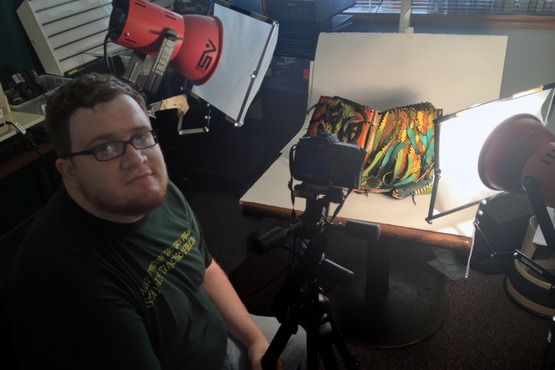
News . Feature Stories . Images reveal CIA's treasured artists' books
News
August 27, 2013
Images reveal CIA's treasured artists' books
Intern created digital archive of books from Special Collections

By Susan Curphey
CIA will be showing off its collection of artists’ books in a new digital image collection, thanks to 100 hours of effort put in by a summer intern.
Very soon, CIA students, faculty, staff and visitors will be able to view more than 200 books from CIA’s nationally recognized collection of more than 1,500 artists’ books in a collection of new, digital images that will be posted on cia.edu and on ARTstor.org, a database of over a million images.
The CIA collection consists of a variety of contemporary works by artists who have turned to the book form or concept for artistic expression and experimentation. Its own genre of art which began in the early 1960s, artists’ books are created in many different shapes, sizes, forms and materials.
Trey Gehring, a textile arts major at Kent State University from Baton Rouge, LA, became fascinated with the collection during a tour of CIA’s library as an introduction to his internship with The Circle Undergraduate Internship Program. The Circle internship is an educational partnership between the Kent State School of Library and Information Science and the libraries and archives of leading educational, medical and cultural institutions in Cleveland, including CIA, the Cleveland Museum of Art, Case Western Reserve University, the Cleveland Clinic, the Cleveland Museum of Natural History, the Cleveland Institute of Music, the Cleveland Orchestra, and the Rock and Roll Hall of Fame.
After seeing a few of CIA’s artists’ books, Gehring proposed the idea of photographing pieces in the collection to create a visual archive of digital images for students to browse, allowing far greater visibility of the works that are normally stored in Special Collections.
“I hope the work I’ve done inspires students to see CIA’s unique collection,” Gehring said. “It incorporates all kinds of art: sculpture, print work and fine art -- anyone interested in art will find something that appeals to them.”
The artists’ books are frequently used by faculty to teach about art and art history, according to Laura Ponikvar, CIA’s image and instructional services librarian.
“The result of Trey’s work will be very useful to our faculty and students; we’re very excited we can share these images with them. They’ll be able to see the many different ways artists interpret books and study them from different angles,” she said.
Artists’ book enthusiasts who are not CIA students or employees will be able to view the new digital image collection by visiting the library.
CIA began collecting artists’ books early in 1981 so the collection is robust, according to Cristine Rom, CIA’s library director. CIA’s collection is known for its many classics, including one of the most notable works of the genre, Edward Ruscha’s, “Twentysix Gasoline Stations,” published in 1963. The new photographs include classic subjects comprising mostly, historically important conceptual books, and recent books representing more physical objects.
“We wanted to show the range of our collection which is historically rich and has grown with the changes in the artists’ book movement,” Rom said. “The photographs provide a way for people to see some of the collection, as well as a way for us to help them find other works in the collection for which we do not yet have images.”
Above: Trey Gehring photographs works from CIA’s artists’ books collection.
Latest Headlines view all
-
April 02, 2024
Cleveland Institute of Art students partner with Progressive Art Collection to exhibit Ready, Set, Relay! -
March 04, 2024
Cleveland Institute of Art announces Curlee Raven Holton Inclusion Scholar Program -
November 06, 2023
Collision of art and artificial intelligence creates murky waters for artists, curators and educators
Questions?
For more information about this or other CIA news, contact us here.
Social Feed